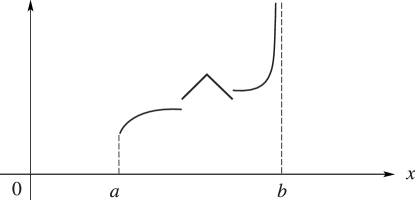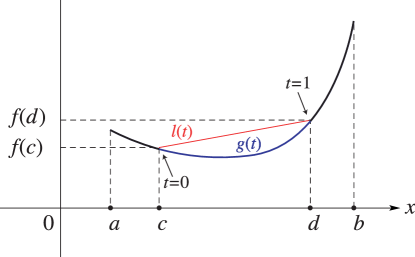§1.4 Calculus of One Variable
Contents
- §1.4(i) Monotonicity
- §1.4(ii) Continuity
- §1.4(iii) Derivatives
- §1.4(iv) Indefinite Integrals
- §1.4(v) Definite Integrals
- §1.4(vi) Taylor’s Theorem for Real Variables
- §1.4(vii) Maxima and Minima
- §1.4(viii) Convex Functions
§1.4(i) Monotonicity
If for every pair , in an interval such that , then is nondecreasing on . If the sign is replaced by , then is increasing (also called strictly increasing) on . Similarly for nonincreasing and decreasing (strictly decreasing) functions. Each of the preceding four cases is classified as monotonic; sometimes strictly monotonic is used for the strictly increasing or strictly decreasing cases.
§1.4(ii) Continuity
A function is continuous on the right (or from above) at if
| 1.4.1 | |||
that is, for every arbitrarily small positive constant there exists () such that
| 1.4.2 | |||
for all such that . Similarly, it is continuous on the left (or from below) at if
| 1.4.3 | |||
If is continuous at each point , then is continuous on the interval and we write . If also is continuous on the right at , and continuous on the left at , then is continuous on the interval , and we write .
A removable singularity of at occurs when but is undefined. For example, with .
A simple discontinuity of at occurs when and exist, but . If is continuous on an interval save for a finite number of simple discontinuities, then is piecewise (or sectionally) continuous on . For an example, see Figure 1.4.1

§1.4(iii) Derivatives
The derivative of is defined by
| 1.4.4 | |||
When this limit exists is differentiable at .
| 1.4.5 | |||
| 1.4.6 | |||
| 1.4.7 | |||
Higher Derivatives
| 1.4.8 | |||
| 1.4.9 | |||
If exists and is continuous on an interval , then we write . When , is continuously differentiable on . When is unbounded, is infinitely differentiable on and we write .
Chain Rule
For ,
| 1.4.10 | |||
Maxima and Minima
A necessary condition that a differentiable function has a local maximum (minimum) at , that is, , () in a neighborhood () of , is .
Mean Value Theorem
If is continuous on and differentiable on , then there exists a point such that
| 1.4.11 | |||
If () () for all , then is nondecreasing (nonincreasing) (constant) on .
Leibniz’s Formula
| 1.4.12 | |||
Faà Di Bruno’s Formula
| 1.4.13 | |||
where the sum is over all nonnegative integers that satisfy , and .
L’Hôpital’s Rule
If
| 1.4.14 | |||
then
| 1.4.15 | |||
when the last limit exists. We do assume that for all in some neighborhood of with .
§1.4(iv) Indefinite Integrals
If , then , where is a constant.
Integration by Parts
§1.4(v) Definite Integrals
Riemann Integrals
Suppose is defined on . Let , and denote any point in , . Then
| 1.4.18 | |||
as . If the limit exists then is called Riemann integrable. Continuity, or piecewise continuity, of on is sufficient for the limit to exist.
| 1.4.19 | |||
and constants.
| 1.4.20 | |||
| 1.4.21 | |||
Infinite Integrals
| 1.4.22 | |||
Similarly for . Next, if , then
| 1.4.23 | |||
Similarly when .
Stieltjes, Lebesgue, and Lebesgue–Stieltjes integrals
A generalization of the Riemann integral is the Stieltjes integral , where is a nondecreasing function on the closure of , which may be bounded, or unbounded, and is the Stieltjes measure. See Riesz and Sz.-Nagy (1990, Ch. 3). Stieltjes integrability for with respect to can be defined similarly as Riemann integrability in the case that is differentiable with respect to ; a generalization follows below.
For the functions discussed in the following DLMF chapters these two integration measures are adequate, as these special functions are analytic functions of their variables, and thus , and well defined for all values of these variables; possible exceptions being at boundary points.
A more general concept of integrability of a function on a bounded or unbounded interval is Lebesgue integrability, which allows discussion of functions which may not be well defined everywhere (especially on sets of measure zero) for . see Rudin (1966), and often used in more abstract mathematical discussions. Similarly the Stieltjes integral can be generalized to a Lebesgue–Stieltjes integral with respect to the Lebesgue-Stieltjes measure and it is well defined for functions which are integrable with respect to that more general measure. See McDonald and Weiss (1999).
Absolutely Continuous Stieltjes Measure
For nondecreasing on the closure of an interval , the measure is absolutely continuous if is continuous and there exists a weight function , Riemann (or Lebesgue) integrable on finite subintervals of , such that
| 1.4.23_1 | |||
| . | |||
Then
| 1.4.23_2 | |||
| integrable with respect to . | |||
In particular, absolute continuity occurs if the function is differentiable, with continuous.
For historical reasons, is also sometimes referred to as a density, as, for example, the mass per unit length at point , see Shohat and Tamarkin (1970, p vii).
Stieltjes Measure with Discontinuous
The utility of the generalization implicit in the Stieltjes measure appears when is not everywhere continuous, but has discontinuous jumps at specific values of , say . See Riesz and Sz.-Nagy (1990, Ch. 3). If, for example, , the Heaviside unit step-function (1.16.14), then the corresponding measure is , where is the Dirac -function of §1.17, such that, for a continuous function on , for and otherwise. Delta distributions and Dirac -functions are discussed in §§1.16(iii), 1.16(iv) and 1.17.
Definite integrals over the Stieltjes measure could represent a sum, an integral, or a combination of the two. Let , , . Then for continuous on ,
| 1.4.23_3 | |||
In the literature where is considered to be a mass density, the are often referred to as mass points, being the mass at that point. Ismail (2005, p 5) refers to these as isolated atoms.
Cauchy Principal Values
Let and assume that and exist when , but not necessarily when . Then we define
| 1.4.24 | |||
when this limit exists.
Similarly, assume that exists for all finite values of (), but not necessarily when . Then we define
| 1.4.25 | |||
when this limit exists.
Fundamental Theorem of Calculus
For with continuous,
| 1.4.26 | |||
| 1.4.27 | |||
Change of Variables
If is continuous or piecewise continuous, then
| 1.4.28 | |||
First Mean Value Theorem
For continuous and and integrable on , there exists , such that
| 1.4.29 | |||
Second Mean Value Theorem
For monotonic and integrable on , there exists , such that
| 1.4.30 | |||
Repeated Integrals
If is continuous or piecewise continuous on , then
| 1.4.31 | |||
Square-Integrable Functions
A function is square-integrable if
| 1.4.32 | |||
Functions of Bounded Variation
With , the total variation of on a finite or infinite interval is
| 1.4.33 | |||
where the supremum is over all sets of points in the closure of , that is, with added when they are finite. If , then is of bounded variation on . In this case, and are nondecreasing bounded functions and .
If is continuous on the closure of and is continuous on , then
| 1.4.34 | |||
whenever this integral exists.
§1.4(vi) Taylor’s Theorem for Real Variables
If , then
| 1.4.35 | |||
| 1.4.36 | |||
| , | |||
and
| 1.4.37 | |||
§1.4(vii) Maxima and Minima
If is twice-differentiable, and if also and (), then is a local maximum (minimum) (§1.4(iii)) of . The overall maximum (minimum) of on will either be at a local maximum (minimum) or at one of the end points or .
§1.4(viii) Convex Functions
A function is convex on if
| 1.4.38 | |||
for any , and . See Figure 1.4.2. A similar definition applies to closed intervals .
If is twice differentiable, then is convex iff on . A continuously differentiable function is convex iff the curve does not lie below its tangent at any point.

